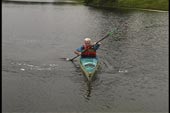Reflections from the Cockpit
"The Ignored Reverse Stroke"
March 2003
Does your reverse stroke work for you or against you?
When I ask the average paddler to quickly stop their sea kayak while they are moving forward, I often wonder if they are going to capsize due the instability they show when stopping. I see the same lack of stability when kayakers use a reverse stroke with a high vertical shaft angle in rough water and surf zones.
Over the years, I feel the paddling community has greatly ignored reverse paddle strokes. The major focus is given to the forward stroke. Since going forward is what we do for most of our sea kayaking career, it makes sense the forward stroke should get the lion share of attention. However, stopping our kayaks and going backwards have suffered as a result.

If you think about the circumstances when fast stops and fast back paddling are necessary, you will realize the traditional reverse stroke does not address the real needs. Everyone knows what happens when they have to quickly stop their bicycle. As you slow to a stop your balance decreases. Stability is present when your moving not stopped. When I watch sea kayakers stopping they remind me of the cyclists I see waiting at the red light. The side to side wobble is typical. If the paddler is in confused waters, their kayak is more susceptible to the water movement when they are stopped. Strokes using high vertical shafts cause your blade to point straight down in the middle of your stroke. If you lost your balance at that point, you will not be in a position for a brace and your likelihood of capsizing increases. You run the same risk when doing sweep strokes with the blade going in the water on knife-edge. It seems obvious to me that some kind of support would be more beneficial to the kayaker.
When you need to back up quickly it is usually to get out of the way or to get to a very specific location. The times I need to go backwards quickly are: assisting in recoveries, getting out of the way of a wave and staying in front of my students as they practice their forward strokes. In all three cases I need speed but precise steering is more important. When I have observed back paddling races, the folks with high vertical shafts are usually the ones all over the place unable to maintain a straight course. Since steering is better achieved with sweep strokes, it is logical to combine your steering needs with a stroke that provides stability.

I have adopted a supportive reverse sweep stroke for stopping and going backwards 99.9% of the time. The stroke is more user friendly, more versatile and provides what is really needed. The only times I use a reverse stoke with a high vertical shaft is back paddling in narrow areas and modeling requirements for certification. The next time you find yourself in need of stopping, try the reverse sweep stroke with a climbing angle on the blade. Try it in the surf zone and you will see what I mean.
Stopping when going backwards has many of the same considerations. Therefore, you can use a supportive forward sweep stroke (climbing angle on the blade) when you find yourself being back surfed by a wave. The support is there when you most need it.
It is common to use techniques we have been taught, without thinking if the techniques are appropriate for all conditions. Just as you have equipment specific skills there are also condition specific skills. The traditional reverse stroke with a high vertical shaft is a technique that does not address the major needs that most of us have when quickly stopping or moving backwards. The reverse supportive sweep stroke does and even more so in rough water.
Wayne Horodowich
Pictures are from "Beyond the Cockpit" - featuring Derek Hutchinson
© Copyright USK